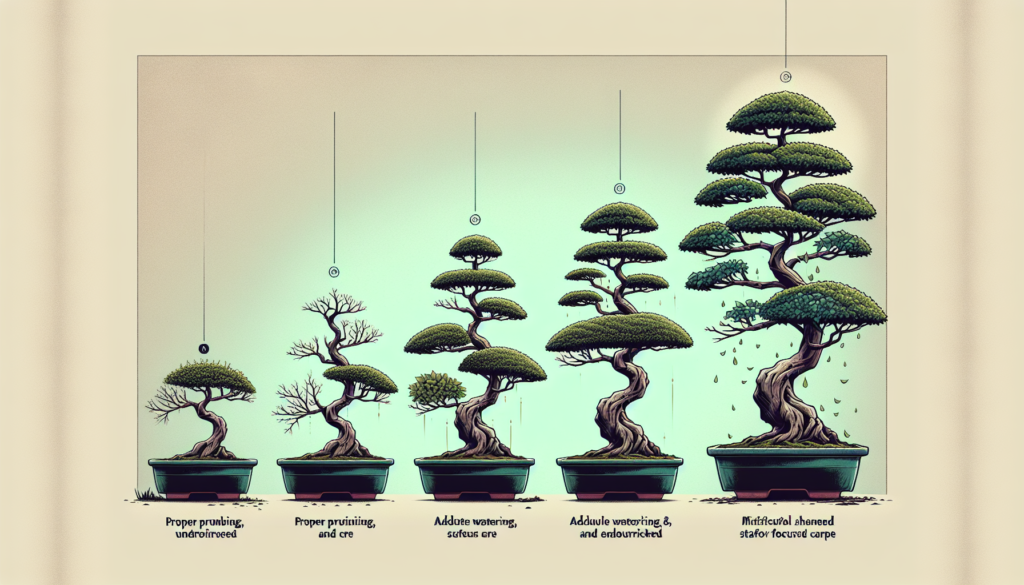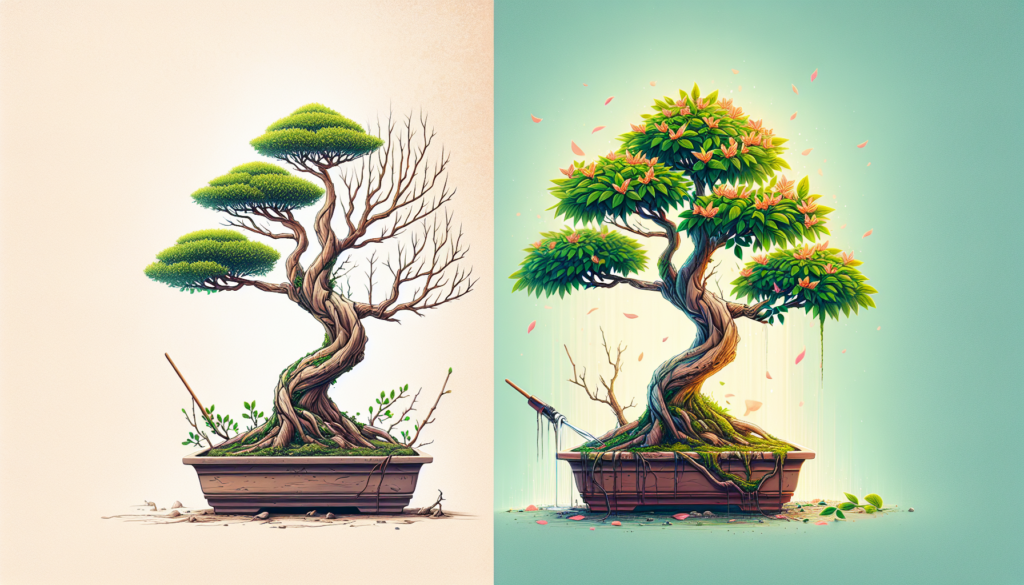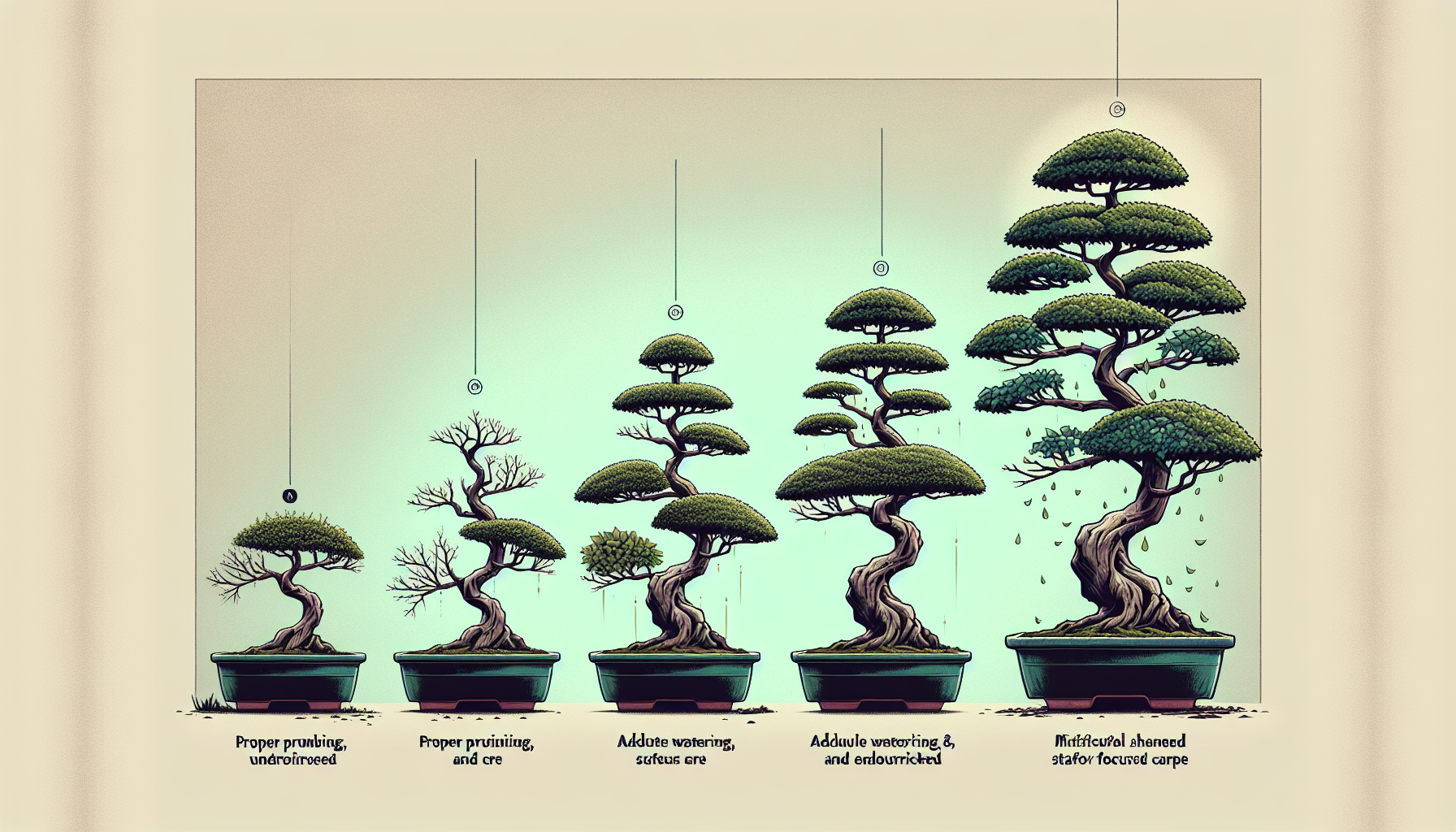Imagine walking into a forgotten corner of your backyard and discovering a neglected bonsai tree, with its once intricate branches now overgrown and wilted leaves drooping sadly. It’s a tragic sight, but fear not! With a little patience and some expert tips, you can bring that bonsai tree back to life, turning it into a beautiful masterpiece that will capture the admiration of all who see it. In this article, we will explore the art of bonsai restoration and guide you step by step on how to revive your neglected tree, transforming it into a vibrant symbol of resilience and beauty.
Understanding Bonsai Negligence
Bonsai negligence refers to the failure to provide proper care and attention to a bonsai tree, leading to its decline and deterioration. It can occur due to various reasons, such as lack of knowledge about bonsai care, busy schedules, or simply neglecting the needs of the tree. Negligent treatment can result in irreversible damage and the eventual death of the bonsai.
Defining Neglected Bonsai
A neglected bonsai can be identified by its poor overall health and appearance. Signs of neglect may include yellowing or browning leaves, weak and stunted growth, excessive or insufficient watering, and presence of pests or diseases. Neglected bonsai trees often display signs of stress, such as withered or drooping branches, and may require immediate attention to prevent further decline.
Common Signs of Neglect
Identifying the common signs of neglect is crucial in understanding the extent of damage inflicted upon the bonsai. Some of these signs include:
- Yellowing or Browning Leaves: This can be an indication of insufficient or improper watering, as well as nutrient deficiency.
- Stunted Growth: If the bonsai has not been given appropriate care, it may exhibit slow or limited growth.
- Lack of Vigor: A neglected bonsai may appear weak and lack vitality, with branches that are easily bendable or breakable.
- Weakened Foliage and Branches: Neglected bonsai trees often exhibit withered or drooping foliage and branches, indicating stress.
- Presence of Pests or Diseases: Inadequate care can make bonsai trees more susceptible to pest infestations and diseases, which can further weaken them.

Potential Long-Term Damage
When a bonsai tree is neglected for an extended period, the long-term damage can be severe. The health of the tree can deteriorate to a point where it becomes challenging, if not impossible, to revive it. Long-term neglect can lead to root rot, defoliation, branch dieback, and even death of the bonsai. Therefore, it is crucial to address neglect as soon as possible to mitigate further damage.
Components of Bonsai Health
To nurse a neglected bonsai back to health, it is essential to understand the key components that contribute to its overall well-being.
Role of Proper Lighting
Proper lighting is vital for the health of a bonsai tree. Most bonsai species require a balance of direct sunlight and shade. Assessing the lighting conditions and ensuring the bonsai receives the appropriate amount of light is crucial for its recovery.
Importance of Regular Watering
Watering is a fundamental aspect of bonsai care. Neglecting to water the tree regularly or overwatering can both be detrimental. Understanding the moisture needs of the bonsai and establishing a consistent watering routine is vital for its revival.
Necessity for Appropriate Temperature
Bonsai trees have specific temperature requirements depending on their species. Neglecting to provide the tree with the right temperature conditions can lead to stress and decline. Maintaining an appropriate temperature range is essential for the bonsai’s well-being.
Value of Adequate Fertilization
Fertilization provides essential nutrients and minerals to the bonsai, promoting healthy growth and overall vigor. Neglecting to fertilize the tree or using improper fertilization methods can result in nutrient deficiencies and hinder its recovery.
Initial Assessment of the Neglected Bonsai
Before taking action, it is crucial to conduct an initial assessment of the neglected bonsai to identify visible problems and gauge its overall health.
Identifying Visible Problems
Inspecting the bonsai for visible issues, such as damaged branches, pests, or diseases, helps in determining the extent of neglect and the necessary steps for revival. Taking note of any abnormalities or signs of stress is important to create an effective recovery plan.
Evaluating Soil Health
The condition of the soil is a crucial aspect of the bonsai’s health. Neglect can lead to compacted, waterlogged, or depleted soil. Evaluating the soil quality helps in understanding if a soil replacement is necessary to restore the bonsai’s vitality.
Checking for Pests or Diseases
Neglected bonsai trees are susceptible to pest infestations and diseases. Conducting a thorough inspection for pests and diseases, such as spider mites, aphids, or fungal infections, is essential. Identifying and addressing these issues promptly is crucial for the bonsai’s recovery.

Immediate Actions to Combat Neglect
To combat neglect and start the process of reviving a bonsai tree, certain immediate actions need to be taken.
Regulating Watering Routine
Establishing a consistent watering routine is crucial for the survival of the bonsai. Adjusting the watering frequency and ensuring proper drainage are necessary steps to prevent over or under watering.
Reviewing Tree’s Light Exposure
Assessing the lighting conditions of the bonsai is essential for its recovery. Providing the appropriate amount of light by adjusting its placement can help restore the bonsai’s vitality and encourage healthy growth.
Starting Emergency Pruning
Pruning plays a significant role in reviving a neglected bonsai. Removing dead or diseased branches, as well as excess foliage, helps redirect the bonsai’s energy towards healthy growth. Immediate pruning should be done to reduce stress and promote recovery.
Rehabilitating the Bonsai’s Soil
The condition of the soil greatly impacts the health of a bonsai. Rehabilitating the soil is a crucial step in reviving a neglected bonsai.
Determining Soil Replacement Need
Assessing the soil quality determines if a complete soil replacement is necessary. Compact, waterlogged, or nutrient-depleted soil may require replacing to provide improved drainage and aeration for the bonsai’s roots.
Choosing the Right Soil Type
Selecting the appropriate soil type is crucial for the bonsai’s recovery. Bonsai-specific soils, such as well-draining and nutrient-rich soil mixes, are available and ideal for creating an optimal growing environment for the tree.
Process of Re-potting
Re-potting the bonsai is vital for its recovery. Properly removing the bonsai from its old container, trimming the roots, and gently placing it in fresh soil promotes healthy root development and overall growth.
Nurse the Bonsai Back to Health
To nurse a neglected bonsai back to health, adjusting the care routine and providing the necessary conditions for growth are essential.
Adjusting Care Routine
Reviving a neglected bonsai requires modifying the care routine to meet its specific needs. Adequate watering, appropriate lighting, and regular fertilization are vital aspects of the revised care routine.
Slow Encouragement for Growth
Encouraging slow and steady growth is crucial for the bonsai’s recovery. Gradual pruning and gentle shaping help the tree recover from its neglected state and develop a healthy form over time.
Monitoring Progress Regularly
Regularly monitoring the progress of the bonsai’s recovery is essential for making adjustments to the care routine, identifying potential issues, and celebrating milestones achieved. Consistent observation helps ensure the bonsai remains on the path to health.
Addressing Disease and Pest Issues
Neglected bonsai trees are prone to pest infestations and diseases. Addressing these issues promptly is crucial for the bonsai’s recovery.
Signs of Infestation
Regularly monitoring the bonsai for signs of pests, such as webs, eggs, or visible insects, helps in early detection. Recognizing the symptoms of common bonsai pests allows for timely intervention.
Safe Removal of Pests
Safely removing pests from the bonsai is important to prevent further damage. Methods such as handpicking, treating with organic insecticides, or introducing beneficial insects are effective in controlling pests without harming the bonsai.
Treatment of Bonsai Diseases
Addressing bonsai diseases involves identifying the specific disease affecting the tree and applying appropriate treatment methods. Fungicides, pruning infected parts, or adjusting environmental conditions may be necessary to combat diseases and aid in the bonsai’s recovery.
Pruning and Wiring a Neglected Bonsai
Pruning and wiring play crucial roles in shaping and refining the appearance of a neglected bonsai tree.
Pruning Tips and Techniques
Pruning should be done strategically to remove dead, damaged, or weak branches and encourage healthy growth. Understanding different pruning techniques, such as root pruning, branch trimming, and leaf pruning, helps in reviving and rejuvenating the bonsai.
Wiring Guidelines
Wiring allows for the manipulation of branches to achieve the desired design and shape. Proper wiring techniques, such as using the right gauge and positioning the wire correctly, prevent damage and aid in shaping the bonsai.
Timing and Frequency
Pruning and wiring should be carried out during the appropriate seasons and with the right frequency. Understanding the specific timing requirements of the bonsai species ensures optimal results and prevents unnecessary stress on the tree.
Maintaining A Healthy Bonsai After Recovery
After successfully reviving a neglected bonsai, maintaining its health is vital to prevent future neglect and ensure its longevity.
Developing Routine Care Schedule
Establishing a routine care schedule ensures that the bonsai receives consistent and appropriate care. It includes regular watering, fertilization, pruning, and monitoring for signs of stress or pest infestations.
Monitoring for Recurring Neglect Signs
Continued vigilance is necessary to identify any signs of recurring neglect. Monitoring the bonsai for yellowing leaves, stunted growth, or pest issues allows for immediate action to prevent further damage.
Preventive Measures for Future Health
Learning from past neglect, implementing preventive measures is crucial to maintain the bonsai’s health. This includes ongoing education about bonsai care, maintaining proper lighting and temperature conditions, and preventive pest control measures.
Learning from Neglect
Understanding the mistakes made in neglecting a bonsai tree is essential for growth and improvement in bonsai care.
Understanding Mistakes Made
Reflecting on the mistakes made in neglecting the bonsai helps identify areas for improvement. It serves as a valuable lesson to avoid repeating similar errors in the future.
Bonsai Care Education
Continuing education about bonsai care is crucial for ensuring competent and responsible care. Expanding knowledge about proper techniques, species-specific requirements, and general bonsai care principles helps prevent future neglect.
Cultivating Respect for Bonsai Art
Through the process of reviving a neglected bonsai, a deeper appreciation and respect for the art of bonsai can be cultivated. Understanding the intricate balance between nature and human intervention in creating and maintaining bonsai trees fosters a greater sense of responsibility towards their care.
In conclusion, reviving a neglected bonsai tree requires a comprehensive approach that addresses the various components of bonsai health. By understanding the signs of neglect, conducting an initial assessment, and taking immediate actions to combat neglect, it is possible to nurse a neglected bonsai back to health. With careful attention to watering, lighting, soil health, and pest control, along with proper pruning and wiring techniques, a neglected bonsai can be restored. Ongoing care and monitoring, coupled with preventive measures and a commitment to learning, ensure the long-term health and longevity of the bonsai. Ultimately, the journey of reviving a neglected bonsai provides valuable lessons in responsible bonsai care and cultivates a deeper appreciation for the art of bonsai.








